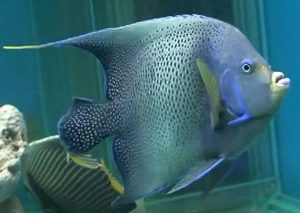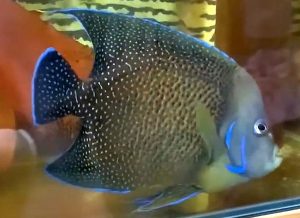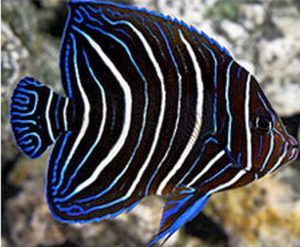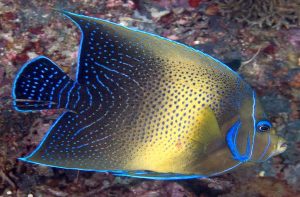Koran Angelfish (Pomacanthus semicirculatus) known to tropical fish keeping enthusiasts as the Semicircled Angelfish, Blue Angelfish, Zebra Angelfish or Halfcircled Angelfish, is found in the Indo West Pacific Ocean around Timor, Bourou, Waigeo, Indonesia, and Port Praslin, New Ireland Island, and Bismarck Archipelago in Papua New Guinea.
From the eastern coast of Africa, its range extends from the southern Red Sea coast of Sudan, as far south as South Africa. In the Indian and Pacific Oceans; it ranges east to Tonga, Fiji, and Samoa; north to southern Japan, and south to Australia.
Around Australian the Koran Angelfish is widespread from the Houtman Abrolhos of Western Australia, around the coast to as far south on the eastern coast as Sydney. Jeveniles have been collected as far south as Merimbula.
In the northeast Indian Ocean, Pomacanthus semicirculatus have been reported at Christmas Island, the Cocos (Keeling) Islands, and in the Tasman Sea; Lord Howe Island.
Since the late 90s, there have also been sporadic reports of Koran Angelfish sightings off the east coast of Florida and the west coast at Oahu, Hawaii.
Koran Angelfish are found on sheltered coral rich reefs at depths between 3 and 150 feet where they graze on algae, sponges, and tunicates. Adults are normally found alone or in pairs around coastal reefs where there are plenty of hiding places, especially around wrecks.
Juvenile Koran Angelfish prefer sheltered areas in shallower areas of the reefs.
Adult Koran Angelfish have a brownish green body color with blue edged scales that give it a speckled look over the body and tail. The body color becomes darker at the rear of the fish. The yellow green head has sapphire blue colored margins around the gills and eyes. The dorsal and anal fins in adults have long trailing filaments, and except for the plain yellow pectoral fins; the rest of the fins are edged in sapphire blue.
Like other Pomacanthus members; the juvenile coloration is much different from adults.
Juvenile Koran Angelfish have a dark, blue black body covered with narrow concentric white and bright
light blue semi-circles. The relatively straight stripes at the head of the fish become curved as they approach the base of the caudal fin.
When Juvenile Pomacanthus semicirculatus grow to around 3 to 6 inches in length, they begin to gradually morph into the adult colors.
Male Koran Angelfish are larger, more pale than females, and have a higher dorsal fin and longer anal fins tha
n females. Fertile female Pomacanthus semicirculatus will normally have a more swollen belly.
The Koran Angelfish is best housed in an aged FOLR aquarium of at least 250 gallon capacity with large amounts of aged live rock for hiding among and grazing on slime algae and cyanobacteria. They need plenty of swimming space and because they nip at soft and stony corals, invertebrates, and clam mantles; are not good candidates for a reef aquarium.
Although some tropical fish keeping enthusiasts manage to successfully keep Pomacanthus semicirculatus with small polyped stony corals and species like Cladiella spp., Lamnalia spp., Litophyton spp., Sinularia spp. that produce a noxious chemical defense; reef tanks are definitely not recommended. Even in a large reef aquarium, they will pick at both hard and soft corals, as well as clam mantles.
Do not keep Koran Angelfish with other angelfish species or smaller fish like gobies, clownfish, or blennies unless the tank is very large.
Koran Angelfish pairs have been observed spawning in a similar manner to Cortez Angelfish. The spawning process begins around sunset with males congregating along the sandy bottom waiting for the arrival of the females. Each male will swim toward and above their female and flutter their bodies in short jittery motions until the female is ready to spawn. When ready, the female will extend all of her fins and rise to the surface with the male moving below her belly to nuzzle it with his nose. As the pair quiver and swim in spirals toward the surface, they simultaneously release white clouds of sperm filled gametes.
A single female Koran Angelfish will scatter in excess of 10,000 eggs for the male to fertilize during each session and during a full spawning cycle a single pair can produce millions of fertilized eggs. The planktonic eggs drift with the current in the water column and hatch around 20 hours after spawning. After hatching, the finless fry live off their yolk sack until it is completely absorbed, at which point they drift down to the bottom of the reef and begin to eat small zooplankton.
Koran Angelfish are an omnivorous species that in their natural environment feed on sponges, tunicates, algae, corals, worms, crustaceans, and mollusks. In an aquarium environment with large amounts of aged live rock, they should be given a varied diet of Spirulina, marine algae, high quality angelfish preparations, and mysis
or frozen shrimp at least three times a day.
Koran Angelfish (Pomacanthus semicirculatus) are popular with tropical fish keeping enthusiasts, especially as juveniles. They can be ordered online from a variety of sources like Saltwaterfish.com at the following approximate purchase sizes; Juvenile Small: 1 1/4″ to 2″; Juvenile Small/Medium: 2″ to 2 1/2″ Juvenile Medium: 2-1/2″ to 3″ Juvenile Medium/Large: to 3 1/2″ to 4″; Juvenile Large: 4″ to 4-1/2″; Changing Medium: 2-1/4″ to 3-1/4″; Changing Large: 3-1/4″ to 4-1/4″; Changing XLarge: 4-1/4″ to 5-1/4″; Adult Small: 2-1/2″ to 3-1/2″; Adult Medium: 3-1/2″ to 5″; Adult Large: 5″ to 7″ Show Size 7″ to 9″
Depending on size and where they are collected from, Koran Angelfish cost anywhere from $60.00 to over $360.00.
Minimum Tank Size: 250 gallons
Aquarium Type: FOLR – Mature live rock
Care Level: Moderate
Temperament: Semi-Aggressive
Aquarium Hardiness: Hardy
Water Conditions: 72 °F – 80 °F, dKH 8 to 12, pH 8.0 – 8.4, sg 1.020-1.025
Max. Size: 16″
Color Form: Black, Blue, Orange, White, Yellow
Diet: Omnivore
Compatibility: Not reef safe
Origin: Australia, New Guinea, Western Pacific, Indian Ocean
Family: Pomacanthidae
Lifespan: 20 years
Experience Level: Intermediate





